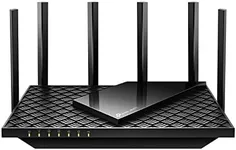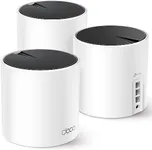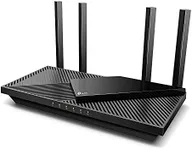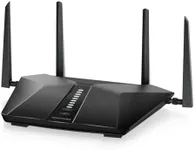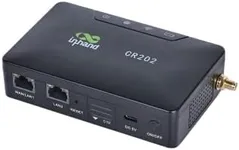Buying Guide for the Best routers
Choosing the right router for your home or office is crucial for ensuring a reliable and fast internet connection. A router is the device that connects your local network to the internet, and it can significantly impact the performance of your internet connection. When selecting a router, it's important to consider several key specifications to ensure it meets your needs. Understanding these specs will help you make an informed decision and get the best performance for your specific situation.Wi-Fi StandardsWi-Fi standards determine the speed and range of your wireless network. The most common standards are 802.11n (Wi-Fi 4), 802.11ac (Wi-Fi 5), and 802.11ax (Wi-Fi 6). Wi-Fi 4 is older and slower, suitable for basic internet usage. Wi-Fi 5 offers faster speeds and better performance, ideal for streaming and gaming. Wi-Fi 6 is the latest standard, providing the highest speeds, improved range, and better performance in crowded environments. Choose Wi-Fi 6 if you have many devices or need the best performance, Wi-Fi 5 for a balance of speed and cost, and Wi-Fi 4 for basic needs.
Dual-Band vs. Tri-BandRouters can operate on different frequency bands, typically 2.4 GHz and 5 GHz. Dual-band routers offer both bands, allowing you to separate devices based on their bandwidth needs. Tri-band routers add an additional 5 GHz band, which can help reduce congestion and improve performance for multiple high-demand devices. If you have many devices or do a lot of streaming and gaming, a tri-band router can provide better performance. For general use with fewer devices, a dual-band router is usually sufficient.
Speed RatingsRouter speed ratings, often listed in megabits per second (Mbps) or gigabits per second (Gbps), indicate the maximum data transfer rate. Higher speeds mean faster internet and better performance for activities like streaming, gaming, and large file transfers. However, the actual speed you experience also depends on your internet service plan. For basic browsing and email, lower speeds (up to 300 Mbps) are adequate. For streaming and gaming, look for speeds of 600 Mbps or higher. For multiple high-demand activities, consider speeds of 1 Gbps or more.
Coverage AreaThe coverage area of a router determines how far the Wi-Fi signal can reach. This is important for ensuring a strong connection throughout your home or office. Coverage is usually measured in square feet. For small apartments or single rooms, a router with a coverage area of up to 1,500 square feet is sufficient. For medium-sized homes, look for coverage of 1,500 to 3,000 square feet. For large homes or offices, consider routers with coverage of 3,000 square feet or more. Mesh systems can also be used to extend coverage in larger areas.
Number of AntennasThe number of antennas on a router can affect the strength and range of the Wi-Fi signal. More antennas generally mean better coverage and stronger signals, especially in larger spaces or homes with multiple floors. Routers with two to four antennas are common and provide good performance for most homes. For larger homes or areas with many obstacles, consider routers with more antennas or those that support beamforming technology, which directs the signal to specific devices for better performance.
Security FeaturesSecurity features in a router help protect your network from unauthorized access and cyber threats. Common security features include WPA3 encryption, firewalls, and guest network capabilities. WPA3 is the latest and most secure Wi-Fi encryption standard, providing better protection for your data. Firewalls help block malicious traffic, and guest networks allow visitors to connect to the internet without accessing your main network. Choose a router with robust security features to ensure your network and data are protected.
Ports and ConnectivityThe number and type of ports on a router determine how many wired devices you can connect. Common ports include Ethernet ports for wired connections and USB ports for connecting storage devices or printers. If you have multiple wired devices, look for a router with at least four Ethernet ports. USB ports can be useful for sharing files or printers over the network. Consider your specific connectivity needs and choose a router with the appropriate number and type of ports.
